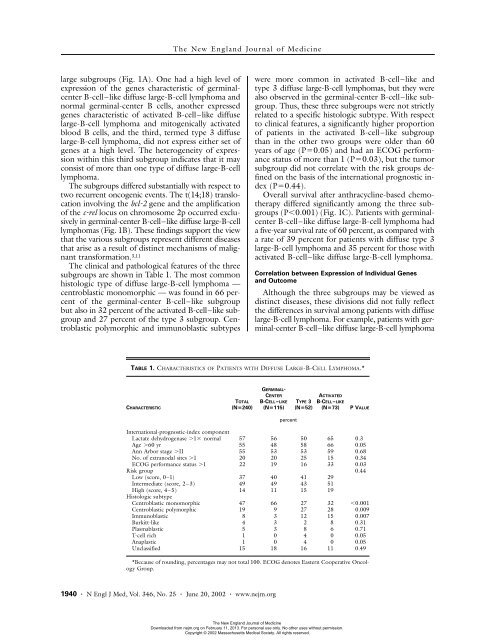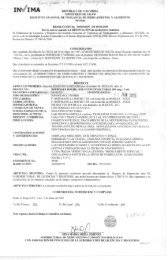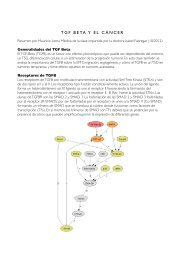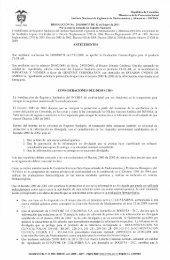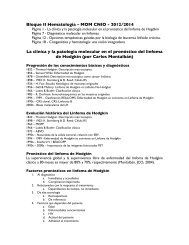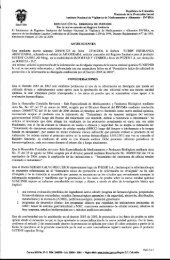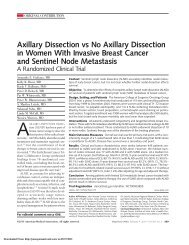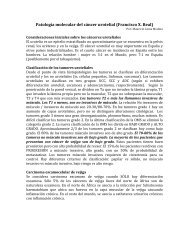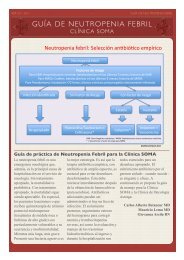DNA microarray in DLBCL
DNA microarray in DLBCL
DNA microarray in DLBCL
- No tags were found...
You also want an ePaper? Increase the reach of your titles
YUMPU automatically turns print PDFs into web optimized ePapers that Google loves.
The New England Journal of Medic<strong>in</strong>elarge subgroups (Fig. 1A). One had a high level ofexpression of the genes characteristic of germ<strong>in</strong>alcenterB-cell–like diffuse large-B-cell lymphoma andnormal germ<strong>in</strong>al-center B cells, another expressedgenes characteristic of activated B-cell–like diffuselarge-B-cell lymphoma and mitogenically activatedblood B cells, and the third, termed type 3 diffuselarge-B-cell lymphoma, did not express either set ofgenes at a high level. The heterogeneity of expressionwith<strong>in</strong> this third subgroup <strong>in</strong>dicates that it mayconsist of more than one type of diffuse large-B-celllymphoma.The subgroups differed substantially with respect totwo recurrent oncogenic events. The t(14;18) translocation<strong>in</strong>volv<strong>in</strong>g the bcl-2 gene and the amplificationof the c-rel locus on chromosome 2p occurred exclusively<strong>in</strong> germ<strong>in</strong>al-center B-cell–like diffuse large-B-celllymphomas (Fig. 1B). These f<strong>in</strong>d<strong>in</strong>gs support the viewthat the various subgroups represent different diseasesthat arise as a result of dist<strong>in</strong>ct mechanisms of malignanttransformation. 3,11The cl<strong>in</strong>ical and pathological features of the threesubgroups are shown <strong>in</strong> Table 1. The most commonhistologic type of diffuse large-B-cell lymphoma —centroblastic monomorphic — was found <strong>in</strong> 66 percentof the germ<strong>in</strong>al-center B-cell–like subgroupbut also <strong>in</strong> 32 percent of the activated B-cell–like subgroupand 27 percent of the type 3 subgroup. Centroblasticpolymorphic and immunoblastic subtypeswere more common <strong>in</strong> activated B-cell–like andtype 3 diffuse large-B-cell lymphomas, but they werealso observed <strong>in</strong> the germ<strong>in</strong>al-center B-cell–like subgroup.Thus, these three subgroups were not strictlyrelated to a specific histologic subtype. With respectto cl<strong>in</strong>ical features, a significantly higher proportionof patients <strong>in</strong> the activated B-cell–like subgroupthan <strong>in</strong> the other two groups were older than 60years of age (P=0.05) and had an ECOG performancestatus of more than 1 (P=0.03), but the tumorsubgroup did not correlate with the risk groups def<strong>in</strong>edon the basis of the <strong>in</strong>ternational prognostic <strong>in</strong>dex(P=0.44).Overall survival after anthracycl<strong>in</strong>e-based chemotherapydiffered significantly among the three subgroups(P1¬ normal 57 56 50 65 0.3Age >60 yr 55 48 58 66 0.05Ann Arbor stage >II 55 53 53 59 0.68No. of extranodal sites >1 20 20 25 15 0.34ECOG performance status >1 22 19 16 33 0.03Risk group 0.44Low (score, 0–1) 37 40 41 29Intermediate (score, 2–3) 49 49 43 51High (score, 4–5) 14 11 15 19Histologic subtypeCentroblastic monomorphic 47 66 27 32


